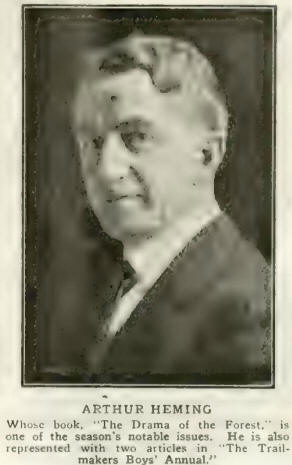|
A Beautiful Backwoods
Book NO more
luxurious piece of book making has been applied to the work of a
Canadian writer in recent years than that which Doubleday, Page & Co.
have given to the production of Arthur Heining’s “The Drama of the
Forests” (Gundy, Toronto; $5.50), nor can it be said that Mr. Heming's
work is not well worthy of its beautiful setting. The only really
certain way of procuring illustrations which are absolutely in keeping
with the reading matter is to have them provided by the man who did the
reading matter. This involves, in many cases, a grave risk that the
writer will prove defective as an illustrator or the artist will prove
inefficient in prose. Mr. Heming began life as an illustrator, and
rapidly rose to the leadership of his profession in he has now developed
a direct, simple, and un-self-conscious style which is well suited to
the adventures in the wilds that occupy most of his volume.
It is a large hook of 325 pages, with 13 full-page illustrations in
colour, but it is a book which no lover of the wilds will willingly lay
down. Mr. Heming knows his wild animals and his Indians and his
habitants and trappers and game wardens as well as anybody now writing
about them. Furthermore, he has a good sense of an anecdote and a neat
and unostentatious way of telling it. Much of the volume has to do with
methods of trapping, some of which are sufficiently start-New York, or
at least that section of it which specializes in the representation of
Wild Life. Much later in his career he began to write, and bring to the
novice. The approved method of obtaining marten is to lure the animal
into a hole in the snow, on the sides of which are boards into which
four nails have been driven so that they project through the boards into
the hole but at such an angle as to allow the animal to enter without
trouble. When he attempts to get out they run into his flesh, and thus
dissuade him from the effort. When the hunter arrives—the rear end of
the marten now projecting from the hole—be places two fingers of each
hand over the four nail points, seizes the animal’s tail with his teeth,
and draws the victim out by throwing back his head. We are not surprised
to read that “such work is rather risky, as the hunter may be bitten
before he has a chance to kill the marten.”

Download
The Drama of the
Forests in pdf format |
